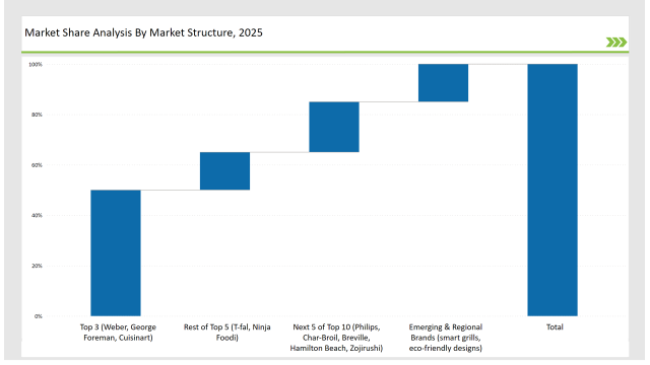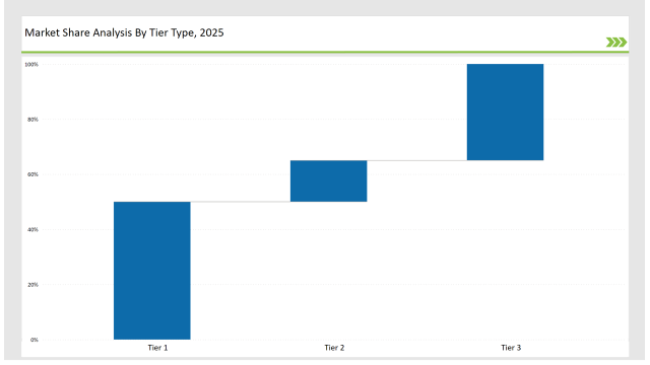Electric grills market is presently witnessing significant growth as customers seek an extremely convenient, smoke-free, and energy-effective grilling solution. The people who live in apartments, condos, and other homes that have minimal outdoor spaces see electric grills as their best bet for indoor cooking, while urbanization and the indoor cooking boom join as supporting factors. Innovation currently includes smart temperature control, non-stick surfaces, and rapid heating technology.
Brands such as Weber, George Foreman, and Cuisinart share 50% of the market because of brand reputation, technological advancements, and significant retail presence. Independent and regional electric grill manufacturers occupy 30% as they cater to niche markets, like high-end culinary enthusiasts and portable grilling solutions. Finally, startups focusing on smart cooking technology, eco-friendly designs, and high-performance electric grills constitute 20% of the market.
Explore FMI!
Book a free demo
| Market Segment | Industry Share (%) |
|---|---|
| Top 3 (Weber, George Foreman, Cuisinart) | 50% |
| Rest of Top 5 (T-fal, Ninja Foodi) | 15% |
| Next 5 of Top 10 (Philips, Char-Broil, Breville, Hamilton Beach, Zojirushi) | 20% |
| Emerging & Regional Brands (smart grills, eco-friendly designs) | 15% |

The electric grills market in 2025 is moderately concentrated, with the top brands capturing 40% to 60% of the market share. Leading manufacturers such as Weber, George Foreman, and Philips dominate the industry, while regional brands and budget-friendly alternatives sustain competition. The market continues to grow, driven by urbanization, health-conscious consumers, and the shift toward smoke-free cooking solutions.
E-commerce Platforms & Direct-to-Consumer Sales dominate with 55%, driven by online convenience, product reviews, and frequent promotions. Retail Appliance & Home Goods Stores hold 25%, offering in-store demonstrations and instant purchase availability. B2B & Commercial Sales (Restaurants, Hotels, Catering Services) account for 15%, supplying professional-grade electric grills. Smart Home & Tech Stores make up 5%, catering to consumers integrating grills with smart home ecosystems.
Indoor & Countertop Electric Grills take the lead with 40%, providing compact, smoke-free cooking for apartment dwellers. Outdoor & High-Performance Electric Grills account for 30%, designed for patio grilling with superior heat distribution. Smart & AI-Powered Electric Grills comprise 20%, with app-controlled temperature settings and automated cooking functions. Portable & Travel-Friendly Electric Grills make up 10%, catering to campers, tailgaters, and small-space users.
As the preference of customers kept changing, the market leaders and new entrants made strategic choices that changed the electric grills industry.

| Tier Type | Tier 1 |
|---|---|
| Example of Key Players | Weber, George Foreman, Cuisinart |
| Market Share (%) | 50% |
| Tier Type | Tier 2 |
|---|---|
| Example of Key Players | T-fal, Ninja Foodi |
| Market Share (%) | 15% |
| Tier Type | Tier 3 |
|---|---|
| Example of Key Players | Philips, Char-Broil, Breville, Hamilton Beach, Zojirushi |
| Market Share (%) | 35% |
| Brand | Key Focus Areas |
|---|---|
| Weber | High-performance smart grills & app integration |
| George Foreman | Smokeless & non-stick indoor electric grills |
| Cuisinart | Multifunctional grills with interchangeable plates |
| Ninja Foodi | Smart cooking sensors & automatic heat adjustments |
| Emerging Brands | AI-powered cooking optimization & portable designs |
The electric grills market is expected to continue its growth trajectory, driven by technological advancements, consumer demand for energy-efficient cooking, and the integration of smart home. Companies focusing on AI-driven cooking, portable designs, and sustainable materials will lead the industry. The future of electric grills is smart, efficient, and tailored for modern lifestyles.
Leading players such as Weber, George Foreman, and Cuisinart collectively hold around 50% of the market.
Independent brands contribute approximately 15% of the market, specializing in portable and high-end culinary grills.
AI-integrated, app-controlled grills hold about 10% of the market, with growth expected in the coming years.
Online sales represent around 55% of the market, as digital shopping and subscription-based grilling solutions expand.
High for companies controlling 50%+, medium for 30-50%, and low for those under 30%.
Western Europe Cosmetics ODM Market Analysis - Size, Share & Trends 2025 to 2035
Korea Women’s Footwear Market Analysis - Size, Share & Trends 2025 to 2035
Japan Women’s Footwear Market Analysis - Size, Share & Trends 2025 to 2035
Western Europe Garment Steamer Market Analysis - Size, Share & Trends 2025 to 2035
Korea Garment Steamer Market Analysis – Size, Share & Trends 2025 to 2035
Japan Garment Steamer Market Analysis - Size, Share & Trends 2025 to 2035

Thank you!
You will receive an email from our Business Development Manager. Please be sure to check your SPAM/JUNK folder too.